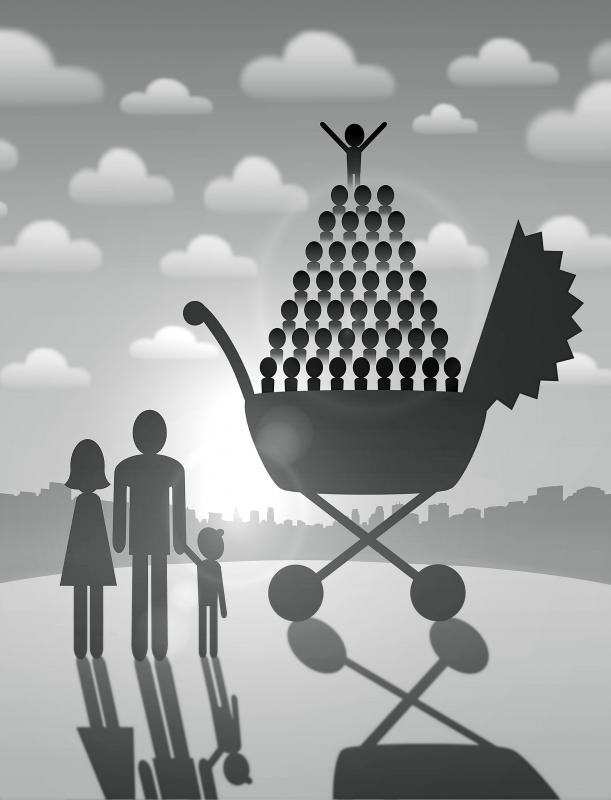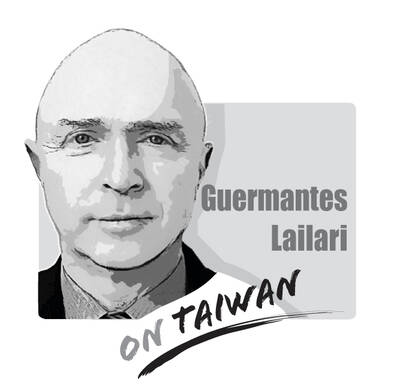As the UK’s COVID-19 vaccination program was “knocked off course” due to a delay in receiving 5 million doses of the AstraZeneca vaccine from India, a far more chilling reality was unfolding: About one-third of humanity, living in the poorest countries, found out that they would get almost no COVID-19 vaccines in the near future because of India’s urgent need to vaccinate its own massive population.
It is somewhat rich for figures in the UK to accuse India of vaccine nationalism. That the UK, which has vaccinated nearly 50 percent of its adults with at least one dose, should demand vaccines from India, which has only vaccinated 3 percent of its people, is immoral.
That the UK has already received several million doses from India, alongside other rich countries such as Saudi Arabia and Canada, is a travesty.

Illustration: Yusha
The billions of AstraZeneca doses produced by Serum Institute of India Ltd are not for rich countries — and, in fact, not even for India alone: They are for all 92 of the poorest countries in the world.
Except they are treated as the sovereign property of the Indian government.
How did we get here? Exactly one year ago, researchers at the University of Oxford’s Jenner Institute, then the frontrunners in the race to develop a COVID-19 vaccine, said that they intended to allow any manufacturer, anywhere, the rights to their jab.
One of the early licenses they signed was with the Serum Institute, the world’s largest vaccine manufacturer.
One month later, acting on advice from the Bill and Melinda Gates Foundation, the university changed course and signed over exclusive rights to AstraZeneca, a UK-based multinational pharmaceutical group.
AstraZeneca and the Serum Institute signed a new deal. The Indian firm would produce vaccines for all poor countries eligible for assistance by Gavi, the Vaccines Alliance, an organization backed by rich countries’ governments and the foundation.
The 92 eligible nations account for half the world population — or nearly 4 billion people.
India’s fair share of these vaccines, by population, should have been 35 percent. However, there was an unwritten arrangement that the Serum Institute would earmark 50 percent of its supply for domestic use and 50 percent for export.
The deal included a clause that allowed AstraZeneca to approve exports to countries not listed in the agreement.
Some countries that asked for emergency vaccine shipments from India, including South Africa and Brazil, were justified: They had nothing else.
However, rich countries like the UK and Canada, which had bought more doses than required to vaccinate their populations, to the detriment of everyone else, had no moral right to dip into a pool of vaccines designated for poor countries.
Paradoxically, when South Africa and India asked the WTO to temporarily waive patents and other pharmaceutical monopolies so that vaccines could be manufactured more widely to prevent shortfalls in supply, among the first countries to object were the UK, Canada and Brazil. They were the very governments that would later ask India to solve their own shortfalls in supply.
The deal did not include restrictions on what price the Serum Institute could charge, despite AstraZeneca’s pledge to sell its vaccine for no profit “during the COVID-19 pandemic,” which led to Uganda, which is among the poorest countries on Earth, paying three times more than Europe for the same vaccine.
An AstraZeneca spokesperson told US media company Politico that the “price of the vaccine will differ due to a number of factors, including the cost of manufacturing — which varies depending on the geographic region — and volumes requested by the countries.”
As it became clear that the Western pharmaceutical industry could barely supply the West, let alone anywhere else, many countries turned to Chinese and Russian vaccines.
Meanwhile, COVAX — a Gavi-backed initiative that does procure vaccines for poor countries — stuck to its guns and made deals exclusively with Western vaccine manufacturers.
From those deals, the AstraZeneca vaccine is now the only viable candidate it has. The bulk of the supply of this vaccine comes from the Serum Institute, and a smaller quantity from SK Bioscience Co in South Korea.
As a result, one-third of humanity is largely dependent on supplies of one vaccine from one company in India.
Cue the Indian government’s involvement. Unlike Western governments, which poured large amounts of money into the research and development of vaccines, there is no evidence that the Indian government has provided a rupee in research and development funding to the Serum Institute. (This did not stop it from turning every overseas vaccine delivery into a photo opportunity.)
New Delhi commandeered approval of every single COVAX shipment sent out from the Serum Institute — even directing how many doses would be sent and when, a well-placed source within the institute said.
The Indian government has not publicly commented on its involvement in the vaccine shipments and has refused requests for comment.
Last month, faced with a surge in COVID-19 infections, New Delhi announced an expansion of its domestic vaccination program to include 345 million people, and halted all exports of vaccines.
About 60 million vaccine doses have already been dispensed, and the Indian government needs another 630 million to cover everyone in this phase alone.
One other vaccine is approved for use — Bharat Biotech’s Covaxin — but it is produced and utilized in smaller quantities.
As more vaccines are approved, the pressure on the Serum Institute might decrease. However, for now, the bulk of India’s vaccination goals are to be met by just one supplier, which faces the impossible choice of either letting down the other 91 countries depending on it, or offending its own government.
The consequences are devastating. To date, 28 million COVAX doses have been produced by the Indian firm for the developing world — 10 million of which remained in India.
The second-largest bulk went to Nigeria, which received 4 million doses, enough to cover less than 2 percent of its population.
Given the new Indian government order of 100 million doses, further supplies to countries like Nigeria might be delayed until July, and, given the Indian government’s need of 500 million more doses in the short run, that date could surely be pushed out even further.
This colossal mess was entirely predictable, and could have been avoided at every turn.
Rich countries such as the UK, the US and those of the EU, and rich organizations such as COVAX should have used their funding of Western pharmaceutical companies to nip vaccine monopolies in the bud.
The University of Oxford should have stuck to its plans of allowing anyone, anywhere, to make its vaccine. AstraZeneca and COVAX should have licensed as many manufacturers in as many countries as they could to make enough vaccines for the world.
The Indian government should have never been effectively put in charge of the well-being of every poor country on the planet.
For years, India has been called “the pharmacy of the developing world.” It is time to rethink that title. We will need many more pharmacies in many more countries to survive this pandemic.
Achal Prabhala is the coordinator of the AccessIBSA project, which campaigns for access to medicines in India, Brazil and South Africa. Leena Menghaney is an Indian lawyer who has worked on pharmaceutical law and policy for two decades.

Chinese state-owned companies COSCO Shipping Corporation and China Merchants have a 30 percent stake in Kaohsiung Port’s Kao Ming Container Terminal (Terminal No. 6) and COSCO leases Berths 65 and 66. It is extremely dangerous to allow Chinese companies or state-owned companies to operate critical infrastructure. Deterrence theorists are familiar with the concepts of deterrence “by punishment” and “by denial.” Deterrence by punishment threatens an aggressor with prohibitive costs (like retaliation or sanctions) that outweigh the benefits of their action, while deterrence by denial aims to make an attack so difficult that it becomes pointless. Elbridge Colby, currently serving as the Under
The Ministry of the Interior on Thursday last week said it ordered Internet service providers to block access to Chinese social media platform Xiaohongshu (小紅書, also known as RedNote in English) for a year, citing security risks and more than 1,700 alleged fraud cases on the platform since last year. The order took effect immediately, abruptly affecting more than 3 million users in Taiwan, and sparked discussions among politicians, online influencers and the public. The platform is often described as China’s version of Instagram or Pinterest, combining visual social media with e-commerce, and its users are predominantly young urban women,
Most Hong Kongers ignored the elections for its Legislative Council (LegCo) in 2021 and did so once again on Sunday. Unlike in 2021, moderate democrats who pledged their allegiance to Beijing were absent from the ballots this year. The electoral system overhaul is apparent revenge by Beijing for the democracy movement. On Sunday, the Hong Kong “patriots-only” election of the LegCo had a record-low turnout in the five geographical constituencies, with only 1.3 million people casting their ballots on the only seats that most Hong Kongers are eligible to vote for. Blank and invalid votes were up 50 percent from the previous
Japanese Prime Minister Sanae Takaichi lit a fuse the moment she declared that trouble for Taiwan means trouble for Japan. Beijing roared, Tokyo braced and like a plot twist nobody expected that early in the story, US President Donald Trump suddenly picked up the phone to talk to her. For a man who normally prefers to keep Asia guessing, the move itself was striking. What followed was even more intriguing. No one outside the room knows the exact phrasing, the tone or the diplomatic eyebrow raises exchanged, but the broad takeaway circulating among people familiar with the call was this: Trump did